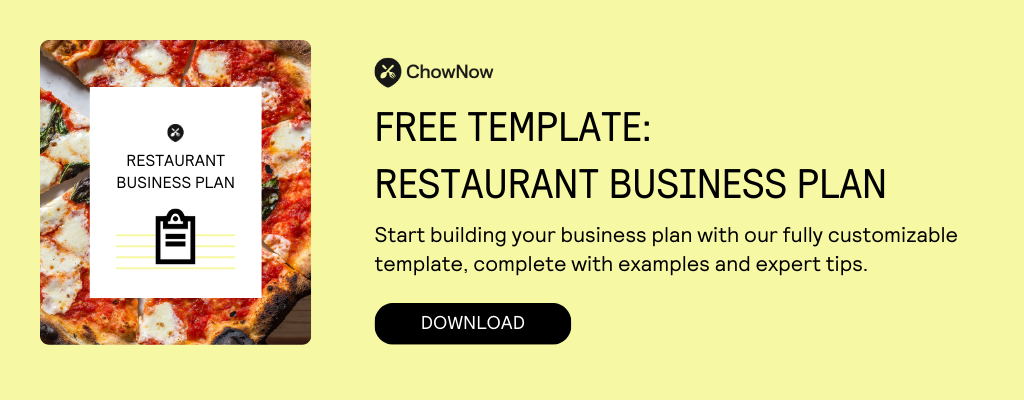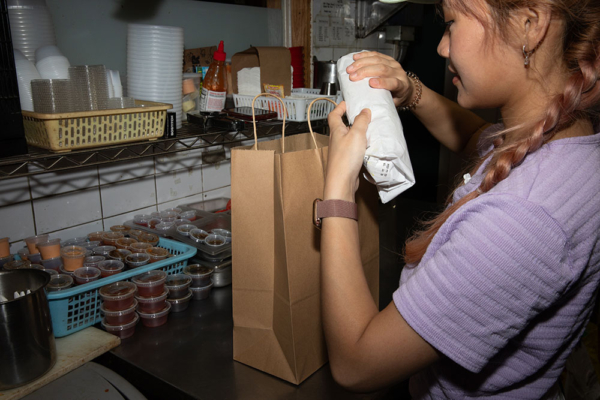How to Write a Restaurant Business Plan [Template Included]

Launching a restaurant is an exciting journey that can be filled with lots of twists and turns, but there’s a lot of effort and intention that goes into the process before you even open your doors to customers. For starters, it’s essential to start off with a well-structured and intentional restaurant business plan. This will help you not only secure funding for your restaurant, but also serve as a clear roadmap for your restaurant’s path to success.
If you’re ready to start building your plan, download our customizable restaurant business plan template.
It can be hard to know where to start, so we created a clear step-by-step guide to writing a small business plan for your restaurant. Keep reading to learn the key elements you should focus on including in your restaurant business plan.
Craft an Executive Summary
An executive summary is a great opportunity to provide a clear snapshot of what you’re trying to accomplish with your restaurant. This might include the overarching concept and an outline on why your particular restaurant and vision will be successful. Be sure to focus on and highlight the details here. This section should include:
Your restaurant’s name and location: Be straightforward, and include your restaurant’s name and the specific location you’ve chosen for your restaurant. Feel free to add some insight as to why you picked the specific location and why it’s the right fit for the customers you’re trying to reach.
A clear and concise mission statement: Briefly state your restaurant’s purpose and core values and indicate why they are particularly relevant and important to you as the business owner.
Concept overview: Describe your restaurant’s theme, cuisine, and unique selling points that make it stand out.
Target market: Identify your primary customer base and include details as to why you’re specifically targeting the particular demographic.
Financial highlights: Summarize all of the important financial projections and any relevant funding needs that will arise.
Check out this article to learn more details about how to create an effective executive summary.
Include a Restaurant Description
Use this section of the business plan to dive deeper into the details of your restaurant, specifically focusing on the concept and what sets it apart from other popular and beloved restaurants in your community.
- Concept and vision: Explain the overall concept of your restaurant. Make sure you highlight the type of cuisine you’ll be offering and the style of your service (casual dining, fine dining, etc.) This will help give a clear picture of how the business will work. This is also a great opportunity to provide more information about the physical atmosphere you’re trying to foster at your restaurant.
- Additional details: Share information on your operating hours, and the capacity of your restaurant, sharing information about how many tables you’ll have and how many people you’ll be able to seat. This is also a good place to mention any additional outdoor seating you might have.
- Legal structure: Clearly specify whether your business is a sole proprietorship, partnership, LLC, or corporation. It’s important to have this legal structure in place before you dive into building out your restaurant as a business.
- Ownership and management: Provide clear details about the restaurant’s owners and any other key members of the management team.
Share a Market Analysis
Conduct clear and thorough research so you can understand your market and help position your restaurant effectively and efficiently.
An overview of the industry: Outline the current state of the restaurant industry and highlight relevant trends that directly apply to the goals, mission and vision you have for your restaurant.
Target market: Similar to the information you included in your overarching executive summary, use the market analysis as an opportunity to define who your ideal customers are, and include information about demographics, income levels, and specific dining preferences.
Competitive Analysis: According to the National Restaurant Association, 45% of restaurant operators expect more intense competition in the coming year—and one of the first steps to beating that competition is understanding what you’re up against. Research and specifically identify the main competitors in your neighborhood, emphasizing their strengths and weaknesses, and outlining how you, as a restaurant owner, plan to differentiate your restaurant and stand out.
Highlight Your Menu and Services
Your menu is the heart and soul of your restaurant. It’s why people ultimately become loyal customers and tell their family and friends to check it out for themselves. Your business plan is a great opportunity to share a sample of the menu, but if you’d rather just share information, make sure you point to the food you will offer at your restaurant and what makes it unique.
Menu details: List the main dishes, beverages, and any specialty items that will be featured on your menu. Be as detailed as possible, including specific descriptions and pricing. Check out this article to learn how to create a menu for your restaurant.
Unique selling proposition: Highlight specific items that make your menu unique and appealing. This could be as broad as featuring local ingredients or as specific as sharing details about signature dishes.
Additional services: Mention any other services that you plan to offer at your restaurant, such as catering, delivery, takeout or the opportunity to rent the restaurant space for private events.
Outline a Marketing and Sales Strategy
Outline how you plan to attract and retain customers.
Branding: Describe your brand identity, including your logo, any color schemes that might apply, and your overall brand message.
Marketing plan: Share information about the strategies you have in place for marketing. This includes – but is not limited to – social media accounts and email campaigns, online advertising, potential partnerships, and promotions.
Sales strategy: Share details on how you will continue to drive sales and manage relationships with customers.
Detail Your Operations Plan
Describe the day-to-day operations of your restaurant to give a clear perspective on what a typical day will look like.
Location and facilities: Provide details about your restaurant’s location and address, including the size of your restaurant, the layout of the space and lease terms.
Staffing and hiring plan: Outline your staffing needs, including specific job titles and responsibilities plans for hiring and any training programs you plan on implementing.
Suppliers and inventory: List the primary suppliers you plan on working with and share information about how you will manage the restaurant’s inventory.
Equipment and technology: Share details on the specific equipment and technology that will be required to run your restaurant efficiently. Highlight which platforms you plan to use for online ordering and delivery, order management, and point-of-sale (POS).
Check out our comprehensive guide to crafting an effective operations plan to learn more.
Share Your Financial Plan
Provide a comprehensive financial overview to demonstrate the viability and potential success of your restaurant. A robust financial plan is critical when seeking support from investors, who will be looking for a breakdown of expected costs in your first year as well as projected revenue.
Startup costs: Opening your own restaurant comes with a lot of costs. Use this section of your business plan as an opportunity to iItemize your initial expenses, including equipment, renovations, licenses and initial inventory that will be needed.
Revenue projections: Forecast your restaurant’s sales for the first few years based on your target market and pricing.
Expense projections: Outline your restaurant’s ongoing expenses, including items such as rent, utilities, labor and food costs. These costs are subject to change, of course, but it’s still important to highlight your initial projections.
Break-even analysis: Calculate when you expect your restaurant to break even and become profitable, picking a precise date. Keep in mind that while you might not hit this exact projection, it’s important to be as realistic as possible.
Funding requirements: Specify how much funding you will need and potential sources that can help with that funding, such as loans or investors.
Include an Appendix
Include any additional information that will help support your restaurant’s business plan.
This might include:
Key management resumes: Provide resumes of the people who will be on your restaurant’s management team to provide information and context on their backgrounds and experiences.
Relevant legal documents: Attach any important legal documents that might be requested. This might include lease agreements or licenses.
Menus and designs: Include detailed versions of your menu and any other relevant design concepts.
Market research data: Attach additional market research data that helps provide context.
Creating a business plan for your restaurant is a critical step towards success. It provides a clear vision, helps you secure funding, and serves as a roadmap for your business. Along with using this blog post as a resource, ChowNow’s all-in-one takeout and delivery platform can help your restaurant set up a foundation for success.
Restaurant Business Plan Frequently Asked Questions
How do you write a business plan for a restaurant?
Include an executive summary, concept details, market analysis, sample menu, marketing strategy, operations plan, and financial projections. Check out our template to get you started.
Why is a restaurant business plan important?
It helps secure funding, clarify your vision, and guide your restaurant’s growth and operations.
What should be included in a restaurant business plan?
Executive summary, restaurant description, market analysis, menu, marketing plan, operations, financials, and appendix.
How long should a restaurant business plan be?
Typically 15–30 pages, depending on the level of detail and supporting documents.


